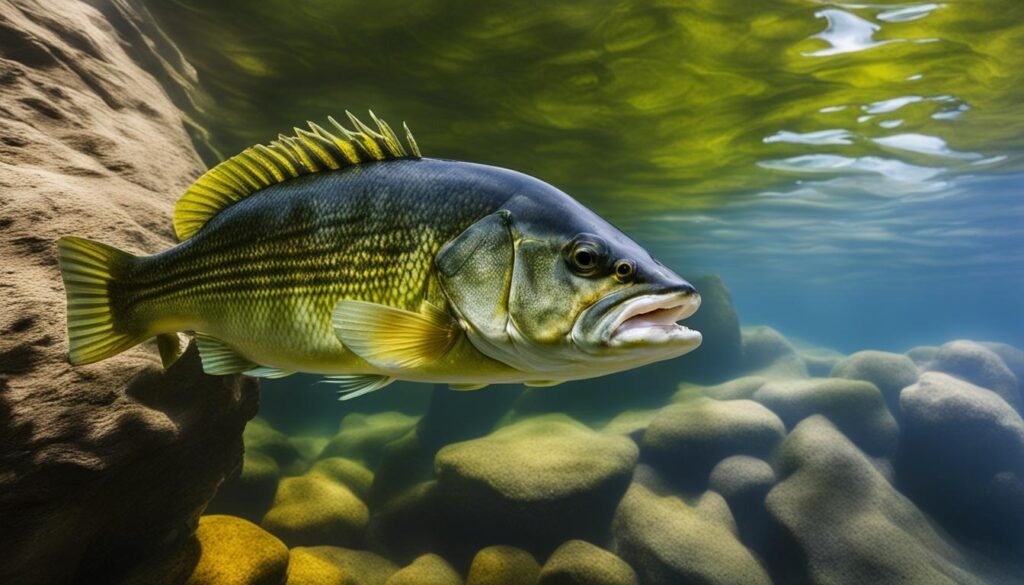Welcome to the world of bass fishing! If you’re new to this exciting sport, understanding the behavior of bass is essential for a successful fishing experience. Largemouth bass, known for their voracious appetite and adaptability, are a popular target for anglers across lakes in the United States.
From their feeding habits to preferred habitats and reproductive patterns, delving into bass behavior offers a deeper understanding of how to entice them to strike. With a wide variety of lures and techniques to choose from, learning the unique attributes of largemouth bass will help you develop effective strategies for catching these powerful predators.

The General Attributes of Largemouth Bass
Largemouth bass, often referred to as the quintessential freshwater game fish, possess a unique set of characteristics that make them an exciting target for anglers. Their reputation for intelligence and curiosity adds to the thrill of bass fishing. With powerful bodies built for strength and maneuverability, these fish can swiftly navigate through the water, making them a challenging catch.
One of the fascinating aspects of largemouth bass is their feeding behavior. They rely heavily on sound and vibrations to detect their prey, but their acute vision also plays a significant role in their hunting strategy. This combination of sensory abilities allows bass to effectively locate and strike at their target.
Size is another notable attribute of largemouth bass. These fish have the potential to grow to impressive proportions, with females generally outweighing males. Anglers often aim to catch trophy-sized bass, making their size an important factor.
To achieve success in bass fishing, understanding these general attributes of largemouth bass is paramount. By leveraging their unique characteristics, anglers can employ appropriate bass fishing techniques and gear, increasing their chances of a rewarding fishing experience.
Important Factors for Bass Movement
To consistently find and catch bass, it is crucial to understand their movement patterns. Knowing where bass are coming from, where they are going, and how they react to different lake and weather conditions is vital.
Factors like water temperature, spawning activities, and seasonal movements play a significant role in bass behavior. Bass tend to be more active in warmer water, so understanding the optimal temperature range for bass fishing can help you identify the best time to cast your line. Additionally, bass spawn in specific areas during specific times of the year. Knowing where and when bass spawn can give you an edge when it comes to finding them.
Each lake may have unique characteristics that influence bass movement, but the insights from seasoned anglers can be applied to any body of water. Expert anglers can provide valuable information and tips on the best bass fishing spots based on their experience in different locations.
The Role of Water Temperature
- Bass tend to be more active and feed more aggressively when the water temperature is between 60°F and 75°F.
- In colder water, bass become less active and tend to seek deeper areas with more stable temperatures.
- Warmer water temperatures can push bass to shallower areas, especially during the early morning and evening hours when they are more likely to feed.
Understanding Spawning Activities
- Bass spawn during specific times of the year, typically in the spring when water temperatures reach around 60°F.
- During the spawn, bass move to shallow areas such as coves, flats, and weed beds to lay their eggs.
- Knowing the timing and locations of bass spawning can help you target these areas and increase your chances of catching bass.
Seasonal Movements
- Bass tend to follow specific seasonal movements, moving to different areas of the lake based on temperature and food availability.
- In the summer, bass often move to deeper water where the temperature is cooler, seeking cover around structures like submerged trees and rock piles.
- In the fall, bass transition to feeding heavily in preparation for the colder winter months, often moving to main lake points and ledges.
- Understanding these seasonal movements can help you locate bass throughout the year and optimize your fishing strategy.
The best time to fish for bass
Timing is crucial when it comes to bass fishing. Knowing the best time to fish for bass can significantly increase your chances of success. The timing depends on various factors such as water temperature, weather conditions, and the behavior of the bass.
Early morning and late evening are generally considered the most active times for bass. During these times, the bass are more likely to be feeding and actively searching for prey. The low light conditions and cooler temperatures make them more active and easier to catch.
Spring is an excellent season for bass fishing due to their aggressive feeding behavior during the spawn. As the water temperature begins to rise, the bass become more active, making it an ideal time to target them. They will be found in shallower water, making them easier to locate and catch.
The best time to fish for bass also depends on the location and the specific habits of the bass in that area. Some bodies of water may have specific patterns or peak feeding times that anglers have discovered over time. Researching local fishing reports or talking to experienced anglers in the area can provide valuable insights into the best time to fish for bass in a specific location.
To further increase your chances of success, consider using technology such as fishing apps like the Fishbox App. These apps provide detailed information on weather conditions, lunar cycles, and expert advice.
Key Points:
- The best time to fish for bass depends on factors such as water temperature, weather conditions, and bass behavior.
- Early morning and late evening are generally considered the most active times for bass.
- Spring is an excellent season for bass fishing due to their aggressive feeding behavior during the spawn.
- Each location may have specific patterns or peak feeding times for bass.
- Consider utilizing technology such as fishing apps to optimize your bass fishing experience.
Understanding bass behavior and movement

To maximize your chances of catching bass, it is essential to understand their behavior and movement. Bass are most active during the day, and their activity levels vary depending on the season. In the spring, bass are more aggressive and can be found in shallow water as they spawn. As the temperature rises in the summer, bass seek deeper water to avoid the heat. Bass behavior is also influenced by factors such as water temperature and weather conditions. Knowing how these factors affect bass behavior can help anglers effectively target and catch bass.
Understanding bass behavior is key to becoming a successful angler. Here are some bass fishing tips to help you gain a better understanding of bass behavior and improve your chances of landing a big catch:
- Pay attention to water temperature: Bass are cold-blooded creatures, and their activity levels are directly influenced by water temperature. In cooler water, bass tend to be sluggish and less active, while warmer water triggers their feeding instincts.
- Consider weather conditions: Bass behavior can be affected by weather conditions such as light intensity, wind, and precipitation. Overcast days can make bass more active and willing to strike, while bright and sunny days may make them seek shelter in deeper water or underneath structures.
- Observe their feeding patterns: Understanding bass feeding patterns is crucial for successful fishing. Bass are opportunistic feeders and will go after anything that resembles their prey. Pay attention to what they are naturally feeding on in your fishing location and select lures or bait that mimic their preferred food source.
- Learn their preferred habitat: Bass are typically found near structures such as rocks, fallen trees, weed beds, and docks. These areas provide shelter and ambush points for bass to hunt their prey. By identifying and targeting these structures, you increase your chances of finding bass.
Factors influencing the best time to fish for bass
When it comes to bass fishing, the timing can make all the difference. Several factors can influence the best time to fish for bass, maximizing your chances of a successful fishing trip.
Seasons play a significant role in bass fishing. Spring is widely regarded as a prime time for bass fishing, as the fish are highly active and aggressively feeding. During the spawn, bass can be found in shallower waters, providing excellent opportunities for anglers.
Water temperature is another crucial factor to consider. Bass activity tends to be more optimal during cooler temperatures, especially in the morning and evening. These times of the day provide ideal conditions for bass fishing, increasing the likelihood of bites.
Weather conditions can also influence bass behavior and their willingness to bite. Overcast days can be advantageous for bass fishing, as the lower light levels make bass more comfortable and increase their feeding activity. Gentle breezes can also help by creating ripples on the water’s surface, attracting bass and making them more likely to strike.
Morning, Mid-Day, and Evening Bass Fishing

The best time to fish for bass can vary throughout the day. Understanding the activity levels of bass during different times can help you plan your fishing trips and increase your chances of success.
Morning Bass Fishing
Early morning is often considered the optimal time for bass fishing. During this time, the bass are actively searching for food, and their activity levels are relatively low. The calmness of the morning water provides an excellent opportunity to catch bass. They are more likely to be found near the shallows, where they can easily target their prey. This is the perfect time to cast your line and lure the bass into biting. Take advantage of the serene atmosphere and the bass’s hunger in the morning for a rewarding fishing experience.
Mid-Day Bass Fishing
Mid-day bass fishing can be more challenging compared to the morning. In sunny conditions, bass tend to seek shelter and deeper areas to avoid the harsh sunlight. However, days with overcast skies or the days following a storm can be productive. During these times, the bass may venture out of their hiding spots to feed, as the weather conditions create a more favorable and comfortable environment. Patience and perseverance are key when fishing for bass during mid-day hours.
Evening Bass Fishing
As the sun sets, late evening becomes another prime time for bass fishing. This time of day offers a unique set of circumstances that can make bass more active and willing to strike. The decreasing daylight triggers the bass’s predatory instincts, and they become more aggressive in their feeding behavior, especially during a full moon. Take advantage of the low light conditions and the bass’s heightened activity levels to increase your chances of landing a catch. With the right technique and lure, you can make the most of the evening hours and end your day of fishing on a high note.
Understanding the behavior and activity levels of bass during different times of the day is crucial for planning effective and successful fishing trips. Whether it’s the tranquility of the morning, the changing conditions of mid-day, or the heightened activity of the evening, each time period presents unique opportunities to catch bass. So grab your gear, head out on the water, and experience the thrill of bass fishing at different times of the day.
Spring Bass Fishing
When it comes to bass fishing, spring is the ideal season to cast your line. As the temperatures rise and nature awakens, bass become more active and hungry after a long winter.
The first sign of spring is the bass spawning season. During this time, bass migrate to shallow water to build nests and lay eggs. This makes them more accessible to anglers as they are concentrated in specific areas.
As the water temperature reaches above 60°F, bass become more aggressive in their feeding behavior. They actively search for food, making it the perfect time to target them with a variety of lures and techniques. From crankbaits to jigs, the options are endless.
Understanding the behavior and habits of bass during the spring is essential for a successful fishing trip. Pay attention to water temperature, weather conditions, and the location of the spawning beds. With this knowledge, you can increase your chances of catching trophy-sized bass.
Utilizing technology for optimal bass fishing
Technology has revolutionized the way we approach bass fishing, and fishing apps like Fishbox App have become indispensable tools for anglers of all skill levels. These apps provide invaluable information to help you optimize your bass fishing experience. With features such as real-time weather updates, lunar cycle predictions, and expert advice, fishing apps can significantly increase your chances of catching bass and maximize your time on the water.
One of the key advantages of using fishing apps is the ability to access accurate weather information. Fishbox App, for example, delivers up-to-date weather forecasts specific to your location. By knowing the current and upcoming weather conditions, you can plan your fishing trips more effectively. Bass activity can vary depending on factors like temperature, barometric pressure, and cloud cover, so staying informed about the weather can greatly improve your chances of success.
In addition to weather data, fishing apps can also provide insights into lunar cycles. The Fishbox App utilizes lunar data to determine the best times to go bass fishing. The gravitational pull of the moon influences fish behavior, and certain lunar phases are believed to trigger bass feeding activity. By leveraging this information, you can strategically plan your fishing outings during peak feeding times and increase your chances of landing that trophy-sized bass.
Whether you’re a beginner or an experienced angler, utilizing technology through fishing apps is a game-changer. Fishbox App, with its user-friendly interface and comprehensive features, not only provides essential information but also allows you to record and track your catches. By analyzing trends and patterns in your fishing data, you can continually refine your bass fishing techniques and make informed decisions on future trips. With technology at your fingertips, you can take your bass fishing skills to the next level and create unforgettable fishing adventures.
Looking For More Bass Fishing Content?
Check out our other bass fishing content to learn more about bass fishing
